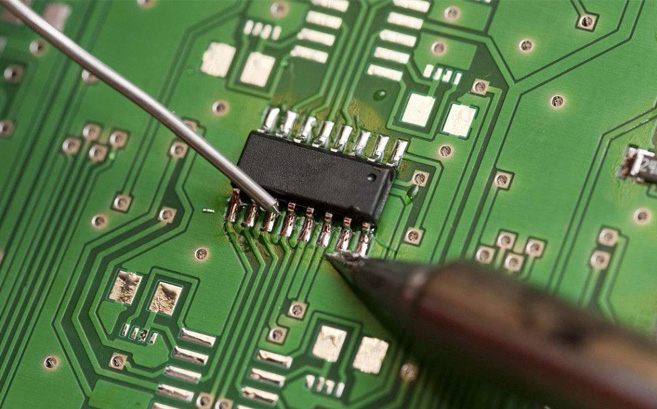PCB soldering refers to soldering components to the PCB (empty board) with production equipment, soldering iron or other tools. Then use the soldering iron to solder the circuit board and the maintenance method of the soldering iron, which will be introduced below.
1. How to use PCB soldering iron
The use, maintenance methods and precautions of the soldering iron for manual PCB soldering
1) Hold the soldering iron in the right hand. Use needle-nose pliers or tweezers to hold the component or wire with your left hand. Before soldering, the electric soldering iron should be fully preheated. To eat tin on the edge of the soldering iron tip, bring a certain amount of solder.
2) Stick the blade surface of the soldering iron tip close to the solder joint. The soldering iron is at an angle of about 60°C with the horizontal. So that the molten tin flows from the tip of the soldering iron to the solder joints. The time that the soldering iron tip stays at the solder joint is controlled within 2 to 3 seconds.

3) Lift the tip of the soldering iron. The left hand still holds the component. After the tin at the solder joint has cooled and solidified, the left hand can be released.
4) Rotate the lead with tweezers to confirm that it is not loose, and then cut off the excess lead with pliers.
Welding quality-When welding, ensure that each solder joint is firmly welded and in good contact. To ensure the quality of soldering, its typical characteristics are bright tin points, smooth without burrs, and moderate tin quantity. The tin and the object to be welded are fused firmly, and there should be no false welding or false welding.
Virtual soldering means that there is only a small amount of solder at the solder joints, resulting in poor contact, which is always on and off. False soldering means that the surface seems to be soldered, but it is not actually soldered. Sometimes the lead can be pulled out of the solder joint by pulling it by hand.
When soldering the circuit board, be sure to control the time. Too long, the circuit board will be burnt, or cause the copper foil to fall off. When removing the component from the circuit board, you can stick the electric iron tip on the solder joint, and pull out the component after the tin on the solder joint is melted.
2. How to maintain the soldering iron
1) Before powering on the soldering iron tip every day, remove impurities from the heating body to prevent the soldering iron tip from getting stuck with the heating element or sleeve, and lock the soldering iron tip at any time to ensure it is in place.
2) During soldering, do not force the soldering iron tip or squeeze the object to be welded, and friction welding cannot be used. This will not help heat conduction and will damage the soldering iron tip.
3) Do not rub the soldering iron tip with objects with rough surfaces.
4) Do not use flux containing chlorine or acid.
5) Do not add any compounds to the tin surface.
6) After the work of the day, when not soldering, wipe the tip of the soldering iron clean and re-dip the tip with new tin, store it on the soldering iron stand and turn off the power.
3. Precautions for the use of soldering iron
1) The newly purchased soldering iron must be dipped in a layer of tin before use (power on the soldering iron, and then use the tin bar to approach the tip of the soldering iron when the soldering iron is heated to a certain level), and file the tip of the soldering iron with a long-used soldering iron Then turn on the power and heat up, and dip the soldering iron tip with a little rosin. When the rosin smokes, apply tin to the surface of the soldering iron tip.
2) The temperature of the electric soldering iron is as high as 250 degrees Celsius after it is energized. It should be placed on the soldering iron stand when not in use, but the power supply should be cut off when it is not used for a long time to prevent the soldering iron tip from being burnt to death (oxidized) at high temperature. It is necessary to prevent the electric soldering iron from damaging other components, especially the power cord. If the insulation layer is burned by the soldering iron, carelessness will easily lead to safety accidents.
3) Don't hit the soldering iron violently, so as not to break the heating wire or lead wire inside the soldering iron and cause malfunctions.
4) After the soldering iron is used for a period of time, tin scale may remain on the tip of the soldering iron. When the soldering iron is heated, the PCB factory staff can wipe it lightly with a damp cloth. If there are pits or oxidized blocks, use a fine-grained file to repair or directly replace the soldering iron tip.